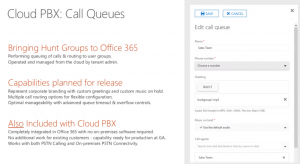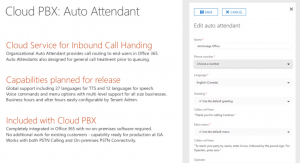The 'front door' to your business via Auto Attendant
The front door to your business matters and here's how Microsoft is helping you promote it!

By now you've properly heard that you can move your phone system to Microsoft and we'll do the work for you. But what if you're using a receptionist or team to talk to your customers through a main number? Will you loose the front door to the business? No, because it's on it's way :D
As of October (planned for) you'll be able to get a preview of Organisational Auto Attendant and Call Queues through https://skypepreview.com, these features provide functions similar to response groups and hunt groups that are prevalent in Skype for Business Server today. But what does this really mean, and why does this make any difference to your business?
Auto Attendant:
Auto attendant is a common term to describe a system that allows callers to be transferred to an extension without the need of a receptionist, thus called an auto attendant/receptionist. It means that a customer calling in can press a key (aka DTMF tone) or by voice, to call an team or person. If the person or team aren't available you can decide to fall-back to an operator. Auto attendant is design for call treatment prior to queuing, see below.
Changing greetings can be pre-recorded or through text to speech if you want to do things quickly or changed on-the-fly.
So...WIIFM?: The business value of this is you don't need to have a human operator on-hand to route calls during your operating hours. Thus saving time and money. Plus this solution will work in full cloud and hybrid scenarios (the ability to call back down to on premises staff members). Another bonus is when these features are for general release, there's no additional cost or license. (Aiming the end of this year).
Call Queuing and Routing (aka, Hunt Groups):
Hunt groups is a common name that's been used for the past 30-40 years within legacy phone systems and Call Queuing works in a similar way, but now available the cloud! This has been a very common request since PSTN calling (Microsoft's cloud phone system) came into life in the UK (17th July 2016) and many customers can't wait to try this out!
Call queuing and routing are responsible for managing queuing, for example, from the auto attendant and scenarios for routing directly to staff members.
WIIFM? This will provide the user/team groups that you most properly use today. The facility to have a number queue for each team within your business and then allow that call through to anyone who's presence is 'available' at that time. Features such as music-on-hold where you can even upload your own customised wav file and multiple call routing options to provide fail-over to another team. End result = customer gets to speak to the right person, regardless of where they physically are. 
Conclusion:
These are enterprise features being provided directly from the cloud. You don't need to have anything on-premises to take advantage of these features and the admin interface is designed for ease of use and quick setup. Want to make a change yourself - easy!
The best way to understand these features are:
Front Door (Welcome) "Auto Attendant" --------> The Hall Way (Calls stack up and waited to be routed) "Call Queuing & Routing" ------> Anywhere (Your Team member)
To see these features in action Jamie Stark and Sean Wilson give a great talk and live demo here. Remember if you want to start testing these features yourself before they are generally available, head over to https://skypepreview.com - See you there!
As the months roll-by we'll see more and more features being added to Cloud PBX.
